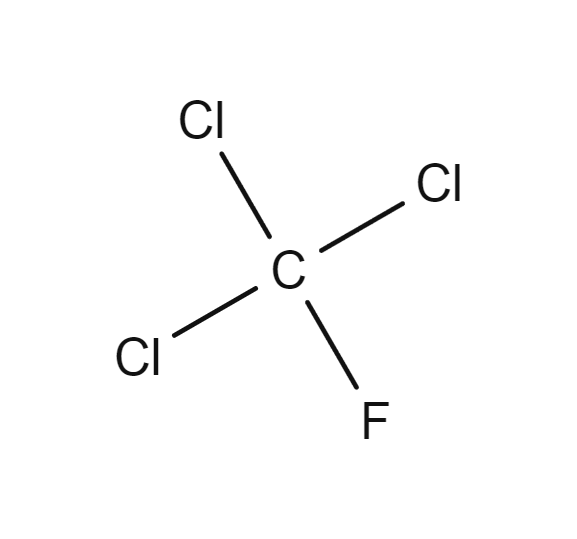
Trichloromonofluoromethane
- CCl3F
- CAS Number 75-69-4
Click & drag to move the 3D molecule
Liquid / Gas Volumes
Calculate the volume or mass of a quantity of gas or liquid
Liquid Phase
At boiling point at 1.013 bar
Gas Phase
In standard conditions (1.013 bar, 15°C)
Physical Properties
Molecule phase diagram showing the transition phases between solid, liquid and gas as a function of temperature and pressure
-
- Molar mass 137.368 g/mol
- Content in dry air /
-
Critical Point
- Temperature 198.05 °C
- Pressure 44.08 bar
- Density 553.90 kg/m³
-
Triple Point
- Temperature -111.11 °C
- Pressure 5.856E-5 bar
Pressure 1.013 bar
| Latent heat of fusion (at melting point) | 50.208 kJ/kg |
| Melting point | - 111.11 °C |
Pressure 1.013 bar
| Boiling point | 23.71 °C |
| Latent heat of vaporization (at boiling point) | 181.358 kJ/kg |
| Liquid density (at boiling point) | 1479.328 kg/m3 |
| Gas density (at boiling point) | 5.851 kg/m3 |
| Specific gravity | 4.9 |
| Vapor pressure | 4.036E-1 bar |
| Specific gravity | 4.9 |
| Vapor pressure | 7.38E-1 bar |
| Compressibility factor Z | 9.6415E-1 |
| Cp/Cv ratio γ | 1.1391 |
| Gas density | 5.8236 kg/m3 |
| Gas/(liquid at boiling point) equivalent | 254.09 vol/vol |
| Heat capacity Cp | 6.0774E-1 kJ/(kg.K) |
| Heat capacity Cv | 5.3352E-1 kJ/(kg.K) |
| Specific gravity | 4.9 |
| Specific volume | 1.717E-1 m3/kg |
| Thermal conductivity | 8.455 mW/(m.K) |
| Vapor pressure | 1.0616 bar |
| Viscosity | 1.0161E-4 Po |
Applications
Examples of uses of this molecule in Industry and Healthcare

Other
Trichlorofluoromethane is a coolant in conditioning systems. It is a bulking agent for polymer foams. It is also used as a degrease solvent for printed circuit boards and to dry clean textiles. It is used as an aerosol propellant in various industries.
Safety & Compatibility
Threshold of toxicity
| PEL USA OSHA (vol) | 1000 ppm |
| VLEP CT France (at Patm and 293.15 K) | 5600 mg/m3 or 1000 ppm |
Metals
| Aluminium | No data |
| Brass | No data |
| Monel | No data |
| Copper | No data |
| Ferritic Steel | No data |
| Stainless steel | No data |
| Zinc | No data |
| Titanium | No data |
Plastics
| Polytetrafluoroethylene | No data |
| Polychlorotrifluoroethylene | No data |
| Polyvinylidene fluoride | No data |
| Polyvinyl chloride | No data |
| Ethylene tetrafluoroethylene | No data |
| Polycarbonate | No data |
| Polyamide | No data |
| Polypropylene | No data |
Elastomers
| Butyl (isobutene- isoprene) rubber | No data |
| Nitrile rubber | No data |
| Chloroprene | No data |
| Chlorofluorocarbons | No data |
| Silicone | No data |
| Perfluoroelastomers | No data |
| Fluoroelastomers | No data |
| Neoprene | No data |
| Polyurethane | No data |
| Ethylene-Propylene | No data |
Lubricants
| Hydrocarbon based lubricant | No data |
| Fluorocarbon based lubricant | No data |
Materials compatibility
Recommendations : Air Liquide has gathered data on the compatibility of gases with materials to assist you in evaluating which materials to use for a gas system. Although the information has been compiled from what Air Liquide believes are reliable sources (International Standards: Compatibility of cylinder and valve materials with gas content; Part 1- Metallic materials: ISO11114-1 (March 2012), Part 2 - Non-metallic materials: ISO11114-2 (April 2013), it must be used with extreme caution and engineering judgement. No raw data such as these can cover all conditions of concentration, temperature, humidity, impurities and aeration. It is therefore recommended that this table is only used to identify possible materials for applications at high pressure and ambient temperature. Extensive investigation and testing under the specific conditions of use need to be carried out to validate a material selection for a given application. Contact the regional Air Liquide team for expertise service.